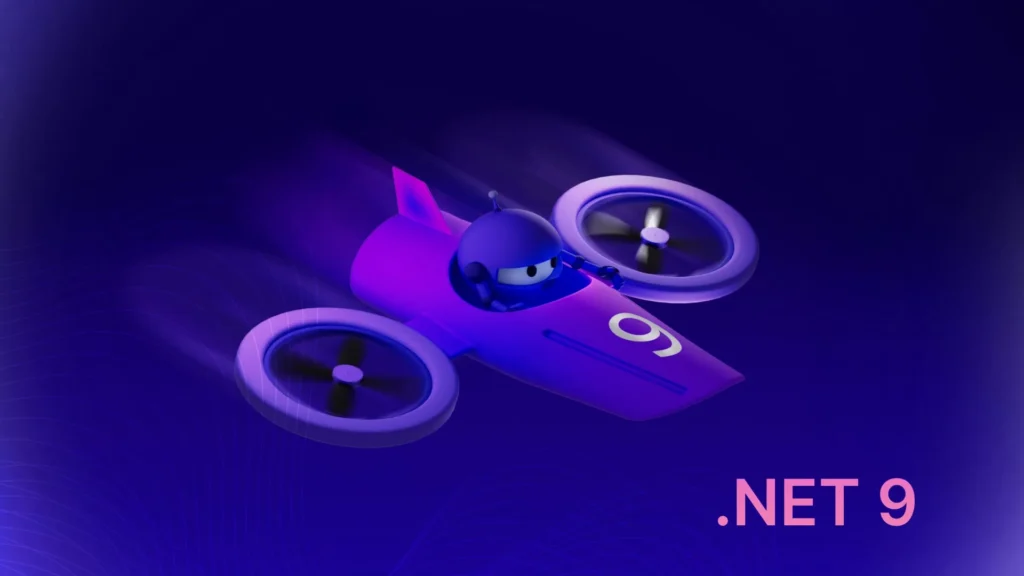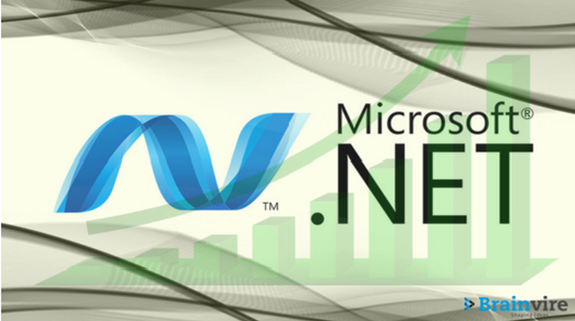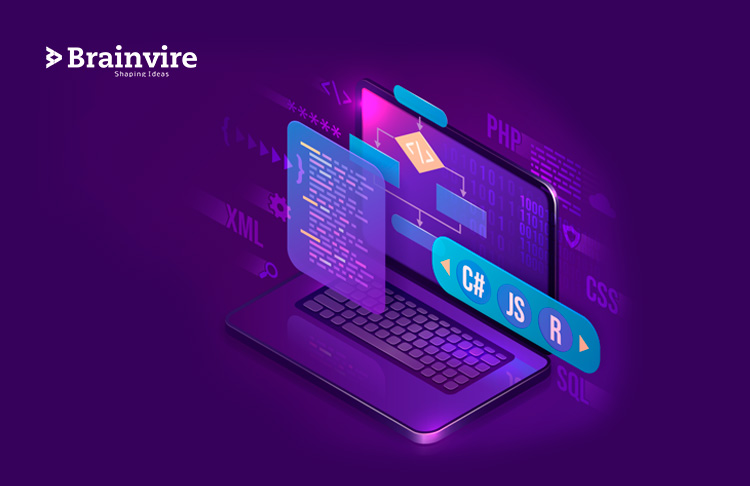Microsoft’s .NET 9 Preview 7 offers a glimpse into the future of ASP.NET development. It has new features, performance enhancements, and expanded cross-platform capabilities. This latest release aims to streamline development, optimize efficiency, and provide developers with powerful tools to build modern applications.
As a Standard Term Support (STS) release, the stable version of .NET 9 is expected later this year, with support spanning 18 months from November 12, 2024, to May 12, 2026. It introduces key improvements in dependency injection, debugging, and Hot Reload, making development more seamless and productive. Whether you’re upgrading from .NET Framework or transitioning from .NET 6, 7, or 8, this version ensures better compatibility while embracing modern development trends.
Designed for cloud-native applications, microservices, and scalable enterprise solutions, .NET 9 continues evolving as a unified, flexible, high-performance framework. Developers can leverage their multi-platform support, enhanced diagnostics, and simplified dependency injection to create robust applications with improved maintainability.
This article explores the crucial updates in .NET 9, why businesses should consider upgrading, and how these advancements impact .NET development services. If you want to stay ahead in the evolving tech landscape, .NET 9 is a significant step forward.
Runtime Enhancements
The latest .NET 9 Preview 7 introduces several key runtime improvements to optimize performance, memory management, and execution efficiency. These enhancements benefit developers targeting ARM64 architectures and those looking for improved garbage collection and loop performance.
| Feature | Description | Benefit |
| ARM64 SVE Support | The Scalable Vector Extension (SVE) enhances data processing efficiency on ARM64 architectures. | Boosts performance for applications running on ARM64 hardware. |
| Post-Indexed Addressing on ARM64 | Implements post-indexed addressing to optimize memory access patterns. | Improves memory access efficiency and cache-friendliness, especially in loops. |
| Strength Reduction in Loops | Replaces complex operations with simpler alternatives inside loops. | Enhances execution speed by reducing computational overhead. |
| Object Stack Allocation for Boxes | Allocates certain objects on the stack instead of the heap. | Reduces garbage collection workload and improves runtime performance. |
| GC Dynamic Adaptation to Application Sizes (DATAS) | Allows the garbage collector to adjust its behavior dynamically based on application size. | Optimizes memory management for applications of varying sizes. |
These enhancements collectively contribute to a more efficient and optimized .NET runtime, particularly for developers working with ARM64 and memory-intensive applications.
Performance Enhancements in .NET 9 Preview 7
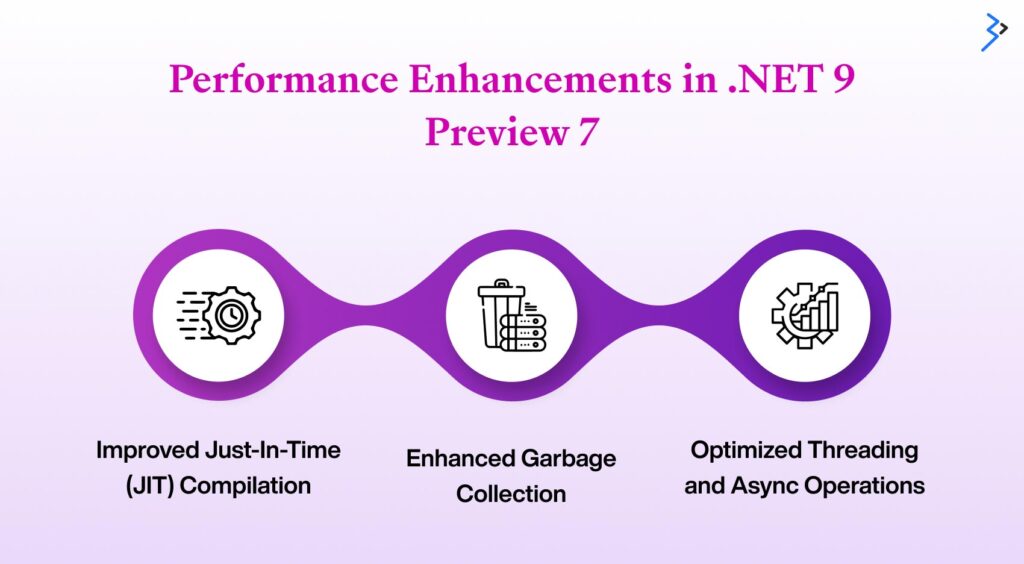
Performance remains a top priority for Microsoft, and .NET 9 Preview 7 brings several optimizations to make applications run faster and consume fewer resources. Some notable improvements include:
1. Improved Just-In-Time (JIT) Compilation
The JIT compiler has been fine-tuned for better performance, reducing execution time and improving application responsiveness. Enhancements in tiered compilation now allow applications to dynamically optimize execution paths, ensuring that high-frequency code is executed efficiently.
2. Enhanced Garbage Collection (GC)
.NET 9 introduces refinements in garbage collection to reduce latency and improve memory management. The updated GC algorithm provides better heap compaction and reduces fragmentation, leading to more stable performance, especially in high-load scenarios.
3. Optimized Threading and Async Operations
Multithreading improvements allow better parallel execution, reducing the time required for computationally intensive tasks. The async/await model has also been optimized to minimize overhead, making asynchronous programming even more efficient.
Read More – What’s new in .NET 9: Innovation, Performance, and AI Integration

Library Updates
The latest preview brings significant changes to .NET libraries:
- Removal of BinaryFormatter: Due to security concerns, the BinaryFormatter serialization method has been removed. Deserializers that allow input to dictate object creation pose potential security risks. Developers are encouraged to adopt safer serialization alternatives.
- ReadOnlySpan<char>.Split() Enumeration: Developers can now enumerate over segments returned by ReadOnlySpan<char>.Split(), provides a more efficient method for handling string splitting operations.
- Compression APIs Utilizing zlib-ng: The compression APIs have been updated to use zlib-ng, which offers improved performance over the traditional zlib library.
- Guid.CreateVersion7 Method: Introduces the ability to create GUIDs with a natural sort order. While much of the data remains random, some portions are reserved for timestamp-based data, allowing these values to maintain a natural sort order.
- Interlocked.CompareExchange for Additional Types: The Interlocked.CompareExchange method now includes overloads for atomically working with byte, sbyte, short, and ushort types, enhancing thread safety operations.
- AES-GCM and ChaChaPoly1305 Support on Apple Platforms: These encryption algorithms are now supported on iOS, tvOS, and MacCatalyst, bolstering security capabilities.
- X.509 Certificate Loading Enhancements: The loading mechanisms of X.509 certificates have been updated, improving security and performance.
- XPS Document Support: Added support for XPS documents from the XPS virtual printer, expanding document handling capabilities.
- Tensor<T> Marked as Experimental: The Tensor<T> class is still experimental, suggesting that data processing skills are gradually improving.
C# Language Updates
C# continues to evolve, bringing new capabilities and refinements that enhance developer experience and application performance. The latest updates introduce significant improvements, particularly in overload resolution, ASP.NET Core development enhancements, and security advancements.
OverloadResolutionPriority Attribute
One of the key additions in this release is the OverloadResolutionPriority attribute, which provides API authors more significant control over method overloads. It can be used alongside the ObsoleteAttribute to maintain backward compatibility while steering users away from outdated methods or properties.
ASP.NET Core Enhancements in .NET 9 Preview 7
.NET 9 Preview 7 introduces several powerful updates to ASP.NET Core, focusing on performance optimizations, security improvements, and enhanced development flexibility.
SignalR and Microsoft.AspNetCore.OpenApi
You may now trim and use Native Ahead-of-Time (AOT) compilation with OpenAPI. Thanks to these advancements, applications may now increase startup performance and decrease their memory footprint. Trimming reduces program size by removing extraneous code, and Native AOT ensures applications run faster on target systems.
Transformer Registration API Enhancements
The Transformer Registration API now provides developers with more options for registering transformers. This enhancement offers greater flexibility in handling request and response transformations, making it easier to tailor APIs to specific business needs. Developers can now define and modify transformations more efficiently, ensuring seamless integration with diverse application requirements.
Pushed Authorization Requests (PAR) in OpenIdConnectHandler
This version supports PAR in the OpenIdConnectHandler, a significant step towards modern web development’s emphasis on security. PAR strengthens the security of authentication requests by preventing unlawful interception and improving conformity with industry authentication standards. With this update, authentication procedures are less likely to be vulnerable since identity providers and apps can communicate more securely.
Kestrel Web Server Updates
The Kestrel Web Server receives significant updates aimed at improving connection handling and customization options:
- Enhanced Connection Metrics: Developers now have access to more detailed metadata about connection failures, which helps them diagnose and resolve networking issues more effectively.
- Named Pipe Endpoint Customization: New options allow greater control over named pipe endpoints, making it easier to configure inter-process communication within applications.
.NET MAUI Advancements
The latest .NET MAUI development services (Multi-platform App UI) update introduces several enhancements to improve hybrid app development, UI customization, and cross-platform compatibility. These updates refine both the developer experience and app performance across multiple platforms.
| Feature | Description | Benefit |
|---|---|---|
| HybridWebView Introduction | A new control for integrating web content with native app features | Enables hybrid app development with seamless web-native interaction |
| TitleBar Control for Windows | Customizable title bar for Windows applications | Enhances UI customization and branding options |
| CollectionView & CarouselView Improvements | New opt-in handler for iOS and Mac Catalyst | Boosts the performance and reliability of UI components |
| ActivateWindow Method | Brings a window to the foreground programmatically | Improves user experience in multi-window applications |
| Lifecycle Methods for Remote Notifications | New methods for handling remote notifications on iOS and Mac Catalyst | Enhances app responsiveness to external events |
| Native Embedding Improvements | Enhancements for embedding native controls in .NET MAUI apps | Increases UI flexibility and native integration capabilities |
| Xcode Sync Support for CLI & VS Code | Synchronization support with Xcode | Simplifies iOS app development workflow |
These advancements make .NET MAUI more robust, offering improved UI flexibility, better integration with platform-specific features, and a smoother development experience.
Read More – Introduction to .NET MAUI: A Comprehensive Beginner’s Guide
Cloud-Native and Containerization Improvements
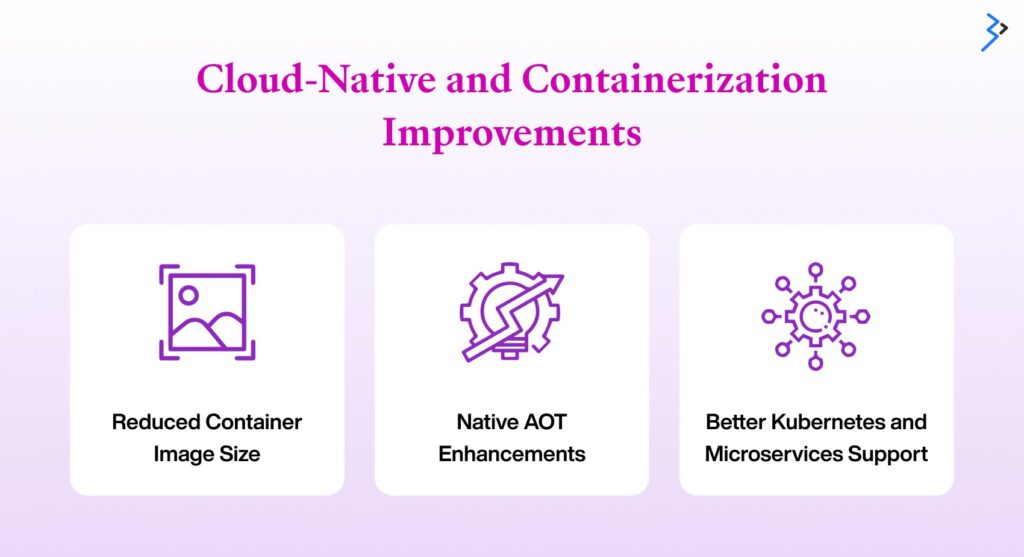
.NET 9 Preview 7 continues Microsoft’s push toward cloud-native development, bringing key enhancements for containerization, serverless computing, and Kubernetes integration.
1. Reduced Container Image Size
Microsoft has optimized .NET 9 container images, reducing their size while maintaining all necessary dependencies. This helps improve deployment speed and minimizes attack surfaces.
2. Native AOT Enhancements
.NET 9 enhances Ahead-of-Time (AOT) compilation, allowing developers to create smaller, faster, and more secure applications by eliminating unnecessary runtime dependencies.
3. Better Kubernetes and Microservices Support
New features for cloud-native development include:
- Enhanced gRPC Support for microservices communication.
- Improved Health Checks and Resilience Patterns in ASP.NET Core.
- Efficient Distributed Tracing with OpenTelemetry integration.
Security and Reliability Enhancements
Security is a critical focus in .NET 9 Preview 7, with several key updates:
1. Stronger Authentication and Authorization
- Support for OAuth 2.1 and OpenID Connect Enhancements
- Simplified Token-Based Authentication for APIs
- Improved Security Defaults for ASP.NET Core Applications
2. Enhanced Code Integrity and Compliance
- Runtime Integrity Checks for better application security.
- Improved Cryptographic APIs ensure better encryption and data protection.
- Automatic Memory Safety Enhancements reduce vulnerabilities such as buffer overflows.
Read More – The Advantages of Using .NET Core for Software Development
Productivity and Developer Experience Improvements
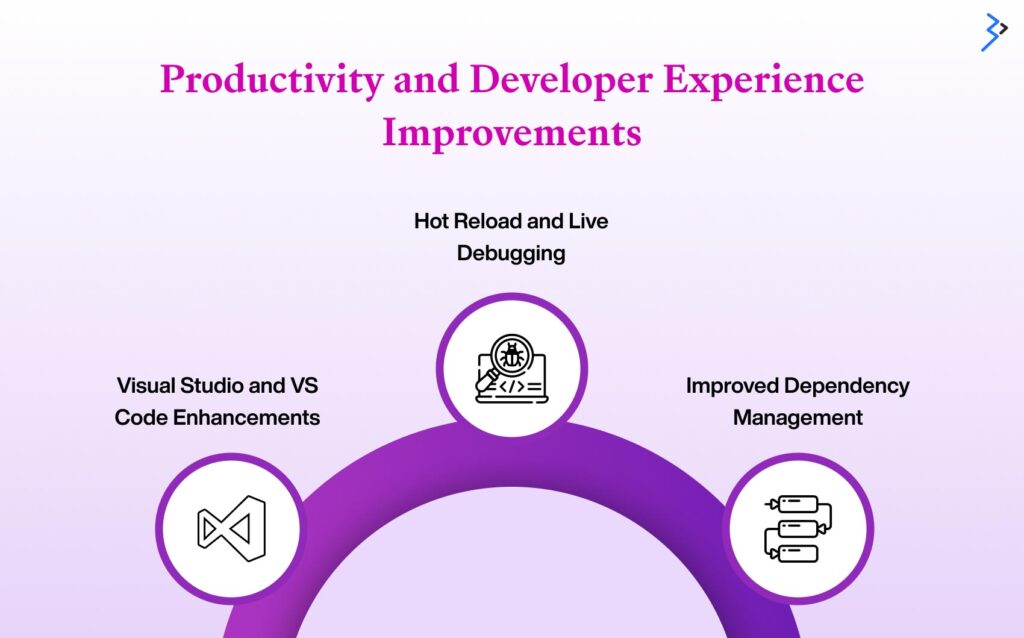
.NET 9 Preview 7 introduces several productivity and developer experience enhancements, making coding, debugging, and dependency management more seamless and efficient.
1. Visual Studio and VS Code Enhancements
Developers using Visual Studio 2024 and VS Code will experience significant improvements in IntelliSense and code suggestions. The latest update brings:
- Better IntelliSense with smarter code completions and suggestions.
- Faster Debugging and Profiling Tools that reduce overhead and enhance application performance.
- AI-Powered Code Assistance is integrated into the IDE, helping developers follow best practices and optimize code.
2. Hot Reload and Live Debugging
Hot Reload in .NET 9 Preview 7 allows developers to modify real-time code without restarting the application. Key enhancements include:
- Instant Code Changes are applied seamlessly, reducing development downtime.
- Improved State Preservation, ensuring that application state remains intact when changes are applied, resulting in a smoother debugging experience.
3. Improved Dependency Management
Dependency management in .NET 9 has been optimized to enhance package handling and minimize conflicts. Improvements include:
- Better Package Management in NuGet offers more efficient package discovery and integration.
- Optimized Dependency Resolution, reducing conflicts and improving build performance by selecting the most compatible versions of dependencies.
The productivity enhancements in .NET 9 Preview 7 streamline development workflows, making coding more intuitive, debugging faster, and dependency management smoother. These updates enable developers to focus more on building high-quality applications while reducing friction in the development process.
Read More – Top 10 Reasons to Migrate from .NET Framework to .NET Core
The Standard Term Support (STS) Model
.NET 9 follows the Standard Term Support (STS) model, meaning it will receive updates and security patches for 18 months. Unlike Long-Term Support (LTS) versions, which are maintained for three years, STS releases are ideal for developers who want to leverage the latest features without committing to long-term stability.
Looking Ahead
With the official release of .NET 9, Microsoft continues refining these features based on developer feedback. Future previews may introduce additional refinements, bug fixes, and optimizations. Developers are encouraged to explore Preview 7, test the new features, and provide feedback to help shape the final release.
For more details and to download .NET 9 Preview 7, visit the official .NET blog.
Related Articles
-
Escalate Your Business Graph Using Dot NET Technology
In the digital age of 21st century, businesses – small or big – are laying great emphasis on adopting cutting-edge Information Technology in order to have a wider outreach. And,
-
6 Reasons That Make ASP.NET Core The Best Framework For Web Application Development
Today, the emergence of web apps has been much easier than it was a few years ago. For web development services, there is now a wide range of platforms and
-
The Benefits of Building Microservices with ASP .NET Core
Microservices with ASP.NET Core have been the talk of the tech world for quite some time. They have not only gained recognition but also helped businesses to streamline activities effortlessly.

